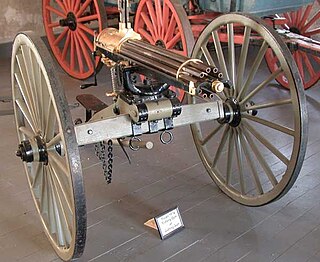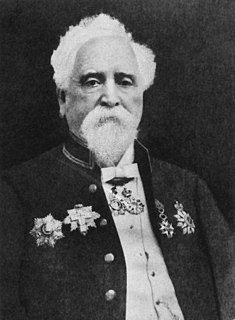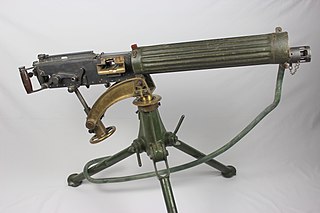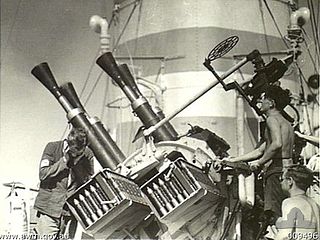Related Research Articles

The Gatling gun is a rapid-firing multiple-barrel firearm invented in 1861 by Richard Jordan Gatling. It is an early machine gun and a forerunner of the modern electric motor-driven rotary cannon.

A machine gun is a fully automatic, rifled autoloading firearm designed for sustained direct fire with rifle cartridges. Other automatic firearms such as assault rifles and automatic rifles are typically designed more for firing short bursts rather than continuous firepower, and not considered machine guns.

An autocannon, automatic cannon or machine cannon is a fully automatic gun that is capable of rapid-firing large-caliber armour-piercing, explosive or incendiary shells, as opposed to the smaller-caliber kinetic projectiles (bullets) fired by a machine gun. Autocannons have a longer effective range and greater terminal performance than machine guns, due to the use of larger/heavier munitions, but are usually smaller than tank guns, howitzers, field guns or other artillery. When used on its own, the word "autocannon" typically indicates a non-rotary weapon with a single barrel. When multiple rotating barrels are involved, such a weapon is referred to as a "rotary autocannon" or simply "rotary cannon".

The Maxim gun is a recoil-operated machine gun invented in 1884 by Hiram Stevens Maxim ; the weapon became the first automatic firearm in production by Vickers and also known as the first automatic firearm in the world, which used .303 British ammunition and a recoil-operating firing system, and required water cooling.

Sir Hiram Stevens Maxim was an American-British inventor best known as the creator of the first automatic machine gun, the Maxim gun. Maxim held patents on numerous mechanical devices such as hair-curling irons, a mousetrap, and steam pumps. Maxim laid claim to inventing the lightbulb.

The Vickers machine gun or Vickers gun is a name primarily used to refer to the water-cooled .303 British (7.7 mm) machine gun produced by Vickers Limited, originally for the British Army. The machine gun typically required a six- to eight-man team to operate: one fired, one fed the ammunition, the rest helped to carry the weapon, its ammunition, and spare parts. Not to be confused with the Maxim machine gun, it was in service from before the First World War until the 1960s, with air-cooled versions of it on many Allied World War I fighter aircraft.

A chain gun is a type of autocannon that uses an external source of power to cycle the weapon's action, rather than diverting excess energy from the cartridges' propellant as in a typical automatic firearm, and does so via a continuous loop of chain drive similar to that used on a motorcycle or bicycle.

A revolver cannon is a type of autocannon, commonly used as an aircraft gun. It uses a cylinder with multiple chambers, like those of a revolver handgun, to speed up the loading-firing-ejection cycle. Some examples are also power-driven, to further speed the loading process. Unlike a rotary cannon, a revolver cannon has only a single barrel, thus its spun weight is lower. Automatic revolver cannons have been produced by many different manufacturers.
Rate of fire is the frequency at which a specific weapon can fire or launch its projectiles. This can be influenced by several factors, including operator training level, mechanical limitations, ammunition availability, and weapon condition. In modern weaponry, it is usually measured in rounds per minute or rounds per second.

The 2-pounder gun, officially designated the QF 2-pounder and universally known as the pom-pom, was a 40-millimetre (1.6 in) British autocannon, used as an anti-aircraft gun by the Royal Navy. The name came from the sound that the original models make when firing. This QF 2-pounder was not the same gun as the Ordnance QF 2-pounder, used by the British Army as an anti-tank gun and a tank gun, although they both fired 2-pound (0.91 kg), 40-millimetre (1.6 in) projectiles.

A rotary cannon, rotary autocannon, rotary gun or Gatling cannon, is any large-caliber multiple-barreled automatic firearm that uses a Gatling-type rotating barrel assembly to deliver a sustained saturational direct fire at much greater rates of fire than single-barreled autocannons of the same caliber. The loading, firing and ejection functions are performed simultaneously in different barrels as the whole assembly rotates, and the rotation also permits the barrels some time to cool. The rotating barrels on nearly all modern Gatling-type guns are powered by an external force such as an electric motor, although internally powered gas-operated versions have also been developed.

Gas-operation is a system of operation used to provide energy to operate locked breech, autoloading firearms. In gas-operation, a portion of high-pressure gas from the cartridge being fired is used to power a mechanism to dispose of the spent case and insert a new cartridge into the chamber. Energy from the gas is harnessed through either a port in the barrel or a trap at the muzzle. This high-pressure gas impinges on a surface such as a piston head to provide motion for unlocking of the action, extraction of the spent case, ejection, cocking of the hammer or striker, chambering of a fresh cartridge, and locking of the action.

A heavy machine gun or HMG is a belt-fed machine gun that fires full-powered/magnum cartridges and is designed to be significantly larger than light, medium or general-purpose machine guns. As the name implies, heavy machine guns are typically not man-portable by infantry and thus require mounting onto a weapons platform to be operably stable or tactically mobile, have more formidable firepower, and generally require a team of personnel for operation and maintenance.

The Puckle gun was a primitive crew-served, manually-operated flintlock revolver patented in 1718 by James Puckle, (1667–1724) a British inventor, lawyer and writer. It was one of the earliest weapons to be referred to as a "machine gun", being called such in a 1722 shipping manifest, though its operation does not match the modern use of the term. It was never used during any combat operation or war. Production was highly limited and may have been as few as two guns.

The Nordenfelt gun was a multiple-barrel organ gun that had a row of up to twelve barrels. It was fired by pulling a lever back and forth and ammunition was gravity fed through chutes for each barrel. It was produced in a number of different calibres from rifle up to 25 mm (1 inch). Larger calibres were also used, but for these calibres the design simply permitted rapid manual loading rather than true automatic fire. This article covers the anti-personnel rifle-calibre gun.

The Gast gun was a German twin barrelled machine gun that was developed by Karl Gast of Vorwerk und Companie of Barmen and used during the First World War. Its unique operating system produced a very high rate of fire of 1,600 rounds per minute. The same principle was later used as the basis for the widely used Gryazev-Shipunov GSh-23L series of Russian aircraft autocannon.

The QF 1 pounder, universally known as the pom-pom due to the sound of its discharge, was a 37 mm British autocannon, the first of its type in the world. It was used by several countries initially as an infantry gun and later as a light anti-aircraft gun.

A multiple-barrel firearm is any type of firearm with more than one gun barrel, usually to increase the rate of fire or hit probability and to reduce barrel erosion/overheating.
Recoil operation is an operating mechanism used to implement locked breech, autoloading firearms. Recoil operated firearms use the energy of recoil to cycle the action.

A repeating firearm, or repeater, is any firearm that is capable of being fired repeatedly before having to manually reload new ammunition into the weapon.
References
- ↑ "CALDWELL MACHINE GUN". Poverty Bay Herald. Vol. XLII, no. 13645. 27 March 1915. p. 4. Retrieved 16 February 2020.
- ↑ USpatent 1090124,Thomas Frederick Caldwell,"QUICK-FIRING MACHINE-GUN",published 1913-08-21,issued 1914-03-10
- ↑ Free Patents: Caldwell Machine Gun
- ↑ Chinn, George M., Lieutenant Colonel, USMC (1951). "APPENDIX A: Patents on Machine Guns and Relating Mechanisms upon which the World's Automatic Weapons Have Been Based". The Machine Gun History, Evolution, and Development of Manual, Automatic, and Airborne Repeating Weapons. Vol. I. Washington, D.C.: Bureau of Ordnance, Department of the Navy. Retrieved 17 February 2020.
CLADWELL,[sic] THOMAS F.--RICHMOND, AUSTRALIA Quick--firing machine gun 1,090,124 10 Mar 1914
- ↑ "CALDWELL MACHINE GUN CO". The Argus. Melbourne. 20 March 1915. p. 21. Retrieved 16 February 2020.